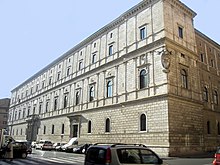Herzog-Max-Palais

The Herzog-Max-Palais was a classicist aristocratic palace at today's Ludwigstrasse 13 in Munich , which was built by Leo von Klenze for Duke Max in Bavaria from 1828 to 1831 . In 1837, Duke Max's second daughter Elisabeth, who later became Empress Sisi of Austria-Hungary, was born in the palace . In 1937/1938 the aristocratic palace was demolished as part of the National Socialist urban redevelopment and Heinrich Wolff started a new neoclassical building for the Reichsbank in its place . It was completed in 1950 by Carl Sattler and today houses the main administration of the Bundesbank in Bavaria.
location
On the west side of Ludwigstrasse, the palace filled the block between the former spring road (today Oskar-von-Miller-Ring) and Schönfeldstrasse (today Rheinbergerstrasse), which is bordered to the west by Fürstenstrasse. It was clearly set apart from the older buildings in the south, which were integrated into a house front, and underlined the princely status of the client.
construction
The three-storey building, the main part of a three-wing complex, was built from 1828 to 1831 according to a design by Leo von Klenze from 1827 for King Ludwig I's brother-in-law , the art-loving Duke Max Joseph in Bavaria (1808–1888), on Ludwigstrasse at 13 Axes, three of which are in a slightly protruding central projection with a simple pilaster arrangement with a triple portal, four further axes symmetrically connected and one risalit-shaped axis each at the corners, set off by double pilasters on the upper floors. The side wings each had 11 axles. A balcony supported by four columns was in front of the central axes. The window design was taken over by the Palazzo della Cancelleria in Rome . The ground floor had arched windows that were inserted into a large square structure; the rectangular windows on the first floor (as the main floor with the Duchess's apartment) were framed in the form of aedicules , while the rectangular windows on the second floor (with rooms for the older children) were simply suspected. The complex was grouped around two rectangular inner courtyards (courtyard of honor and courtyard). The client had a circus built on the adjoining garden at the rear by 1833.
Furnishing
Klenze was largely responsible for the equipment. As an artist he involved Wilhelm von Kaulbach , Robert von Langer and Clemens von Zimmermann , as well as the sculptors Ernst Mayer and Ludwig von Schwanthaler . The themes of the furnishings were predominantly taken from ancient mythology (including Amor and Psyche von Kaulbach in the ballroom; deeds of Hercules von Langer; plastic frieze of the procession of Bacchus von Schwanthaler). The two-storey ballroom in the right side wing with galleries on consoles on the narrow sides and a diagonally coffered ceiling that leaned against Schinkel's theater in Berlin was famous. Some of Langer's frescos have been preserved in the seminar building at Ludwigstrasse 28 (built as a house of German law during the Nazi era). Parts of the parquet were reused in the new building.
Appreciation
The palace is known as “probably the most beautiful aristocratic palace that Leo v. Klenze ... has established “. The future Empress Elisabeth of Austria-Hungary (Sisi) was born here in her father's palace in 1837 .
The Herzog-Max-Palais served as a model for the Kronprinzenpalais in Stuttgart, which was built between 1846 and 1850 and also demolished in 1962/1963.
Individual evidence
- ^ Leo von Klenze, architect ..., p. 409
- ↑ https://www.bundesbank.de/de/bundesbank/hauptverwaltungen-filialen/by
- ^ H. Lehmbruch in "Romanticism and Restoration", p. 479.
- ↑ http://www.semversorgung.vwl.uni-muenchen.de/emeriti/Langer-Fresken/Langer-Fresken.htm
- ↑ Erwin Schleich, The Second Destruction ..., p. 23
- ↑ On Frank Büttner's equipment: Klenze and the visual artists, in: Leo von Klenze, architect ..., pp. 145 ff., In particular pp. 153–154; Brigitte Langer: Leo von Klenze as interior and furniture designer, ibid, p. 157 ff.
- ↑ Erwin Schleich, The Second Destruction ..., p. 22
literature
- Winfried Nerdinger (Ed.): Leo von Klenze. Architect between art and court 1784 - 1864 . Exhibition catalog Münchner Stadtmuseum 2000. Munich / London / New York: Prestel, esp. Pp. 405–409. ISBN 3-7913-2292-3 .
- Erwin Schleich : The second destruction of Munich . New series of publications by the Munich City Archives, vol. 100. Stuttgart: Steinkopf, 2nd ed. 1981, pp. 22–23. ISBN 3-7984-0530-1 .
- Bettina Corßen: The Herzog-Max-Palais . Master thesis Munich 1984.
- Hans Lehmbruch: The palace of Duke Maximilian in Bavaria on Ludwigstrasse in Munich, 1828 - 1831 . In: Wilfried Nerdinger (Ed.): Romanticism and Restoration. Architecture in Bavaria at the time of Ludwig I, 1825 - 1848. Munich: Hugendubel, 1987, pp. 479–482. ISBN 3-88034-309-8 .
- Barbara Kuhn: From the Herzog-Max-Palais to the state central bank. History of the house at Ludwigstrasse 13 . Self-published by the Landeszentralbank in Bayern 1990. ISBN 978-7100109765 .
- Frank Büttner: Ancient Heroes in Munich Classicism. Robert von Langer's frescoes in the Economics Library , in: Insights. Research at the Ludwig-Maximilians-Universität München, vol. 1999, issue 2, pp. 34–52.
- Karl Stankiewitz : Off is and off is! Taverns, theaters, cafés, night clubs and other lost places of Munich conviviality . Allitera Verlag, Munich 2018, ISBN 978-3-96233-023-1 .
Web links
- Website about the palace
- The palace in a depiction of Ludwigstrasse by Johann Baptist Kuhn (1840), Munich: Stadtmuseum, graphic collection
Coordinates: 48 ° 8 ′ 44.4 " N , 11 ° 34 ′ 43.1" E



